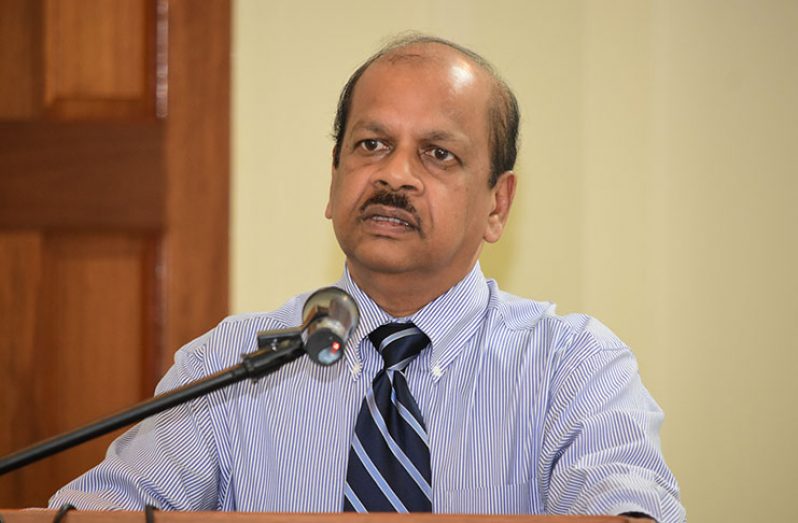THE Bank of Guyana (BoG) has maintained its monetary stability despite many challenges this year and looks forward to the implementation of many projects come 2017.
The bank’s Governor, Dr Gobind Ganga, told reporters on Thursday during a press conference that at the end of September, licensed financial institutions (banks and non-banks) remained liquid, capitalised and profitable.He noted that the capital adequacy ratio (CAR) for all licensed, deposit-taking financial institutions surpassed the 8 per cent minimum requirement. The industry’s CAR stands at 27.1 per cent or 1.4 per cent above the December 2015 ratio, thereby indicating that the sector has “adequate buffer to support it in adverse times.”
Dr. Ganga said too that Licensed Financial Institutions’ profit at the end of September 2016 amounted to $9,227M or 68 per cent above the 2015 cumulative profits. As it relates to liquidation, the levels remained high with the holdings of liquid assets surpassing the statutory minimum requirements.
“Reserves with the Bank of Guyana also exceeded the statutory minimum required level,” the Governor said. He continued: “At September 30, 2016, total assets for the Licensed Financial Institutions amounted to %553B or 3.7 per cent above December 2015. The commercial banks accounted for 82.4 per cent or $455.5B of total assets, up from 81.3 per cent or $433.5B at the end 2015.”
The Governor said too that the asset base were deposits of $433.9B representing a 5.6 per cent or $23B rise over the December 2015 level. “This continued to signal the high level of confidence in the safety and stability of the financial sector.”
Moreover, at the end of September this year, total investments were pegged at $152B and represented 28 per cent of the industry’s total assets. Foreign investment accounted for 33 per cent of the total investments, of which 92 per cent were in United States dollars.
Additionally, the aggregate credit portfolio of the credit-giving, Licensed Financing Institutions was $260.2B,
while credit to the private sector recorded a marginal increase, growing by less than 1 per cent, or $0.8B to $215.3B. Credit to the real estate sector also rose by 3 per cent to $122.9B and accounted for 46.1 per cent of the total credit when compared to 45.9 per cent at the end of December 2015.
But the successes of the Central Bank did not come without challenges and Dr Ganga said non-performing loans proved a major challenge. He said non-performing loans were and continue to be a “major challenge” to the financial sector. In the past 18 months, the Governor said there have been elevated levels of non-performing loans, which were comparable to levels in the Caribbean.
“This was due in part to the decline in non-oil commodity prices and reclassification of exposures by a few banks,” he said, while indicating that non-performing loans represented 11.3 per cent of the industry’s total portfolio.
As a result, non-performing loans remain the focus of intense scrutiny by the Bank of Guyana as we continue to monitor and encourage financial institutions to implement measures to reduce same.
Another major challenge affecting the country is de-risking, which refers to financial institutions restricting or terminating correspondent banking relationships with clients or categories of clients in order to avoid risk. Dr Ganga said while foreign-owned banks operating in Guyana have not been subjected to de-risking, locally owned banks have been hard hit by de-risking, losing in aggregate, close to 37 per cent of correspondent relationships by the end of June 2016.
“The two affected were able to establish new correspondent relationships to cover about 75 per cent of those relationships that were lost. Each bank has at least one correspondent bank and we are working with the banks to establish other correspondent banks.”
He said too that a major concern with the spate of de-risking is that legitimate transactions may go underground, thereby encouraging the use of cash and increase other informal means. The result he said is likely to undermine the efforts to supervise and regulate the financial sector, fight money- laundering and combat the financing of terrorism.
Additionally, “Guyana has enhanced compliance with the implementing of recommendations by the Financial Action Task Force (FATF) and the Financial Stability Board. Along with our CARICOM counterparts and other financial institutions, we continue to advocate with commercial banks in the United States of America and other countries to determine an appropriate way forward.”
Come next year, the bank intends to embark on a number of projects, namely, the Financial Consumer Protection project which is aimed at developing a formal legal and institutional framework on market conduct or financial consumer protection. That project which begun this year serves to educate and protect financial consumers, thereby building resilience against exploitation.
As part of the follow-up process, an action plan would be delivered with recommended reforms that are aimed at addressing the gaps and the drafting of financial consumer- protection legislation and regulations. The BoG has taken a policy decision to bring the supervision and regulation of credit unions under the purview of the bank , while describing the area as a “supervisory blind spot.” In this regard, the entity intends to conduct an in-depth audit of the credit union sector with emphasis being placed on corporate governance, credit business, liquidity, solvency and performance. Agency banking and a new national payment system are also projects that the bank intends to work on next year.
Central Bank maintains monetary stability
SHARE THIS ARTICLE :
Facebook
Twitter
WhatsApp



.jpg)









